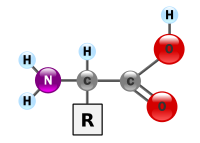
Photo from wikipedia
Blood biomarkers may be used to detect physiological imbalance and potential disease. However, blood sampling is difficult and expensive, and not applicable in commercial settings. Instead, individual milk samples are… Click to show full abstract
Blood biomarkers may be used to detect physiological imbalance and potential disease. However, blood sampling is difficult and expensive, and not applicable in commercial settings. Instead, individual milk samples are readily available at low cost, can be sampled easily and analysed instantly. The present observational study sampled blood and milk from 234 Holstein dairy cows from experimental herds in six European countries. The objective was to compare the use of three different sets of milk biomarkers for identification of cows in physiological imbalance and thus at risk of developing metabolic or infectious diseases. Random forests was used to predict body energy balance (EBAL), index for physiological imbalance (PI-index) and three clusters differentiating the metabolic status of cows created on basis of concentrations of plasma glucose, β-hydroxybutyrate (BHB), non-esterified fatty acids (NEFA) and serum IGF-1. These three metabolic clusters were interpreted as cows in balance, physiological imbalance and "intermediate cows" with physiological status in between. The three sets of milk biomarkers used for prediction were: milk Fourier transform mid-IR (FT-MIR) spectra, 19 immunoglobulin G (IgG) N-glycans and 8 milk metabolites and enzymes (MME). Blood biomarkers were sampled twice; around 14 days after calving (days in milk (DIM)) and around 35 DIM. MME and FT-MIR were sampled twice weekly 1-50 DIM whereas IgG N-glycan were measured only four times. Performances of EBAL and PI-index predictions were measured by coefficient of determination (R2cv) and root mean squared error (RMSEcv) from leave-one-cow-out cross-validation (cv). For metabolic clusters, performance was measured by sensitivity, specificity and global accuracy from this cross-validation. Best prediction of PI-index was obtained by MME (R2cv = 0.40 (95 % CI: 0.29-0.50) at 14 DIM and 0.35 (0.23-0.44) at 35 DIM) while FT-MIR showed a better performance than MME for prediction of EBAL (R2cv = 0.28 (0.24-0.33) vs 0.21 (0.18-0.25)). Global accuracies of predicting metabolic clusters from MME and FT-MIR were at the same level ranging from 0.54 (95 % CI: 0.39-0.68) to 0.65 (0.55-0.75) for MME and 0.51 (0.37-0.65) to 0.68 (0.53-0.81) for FT-MIR. R2cv and accuracies were lower for IgG N-glycans. In conclusion, neither EBAL nor PI-index were sufficiently well predicted to be used as a management tool for identification of risk cows. MME and FT-MIR may be used to predict the physiological status of the cows, while the use of IgG N-glycans for prediction still needs development. Nevertheless, accuracies need to be improved and a larger training data set is warranted.
Journal Title: Preventive veterinary medicine
Year Published: 2020
Link to full text (if available)
Share on Social Media: Sign Up to like & get
recommendations!